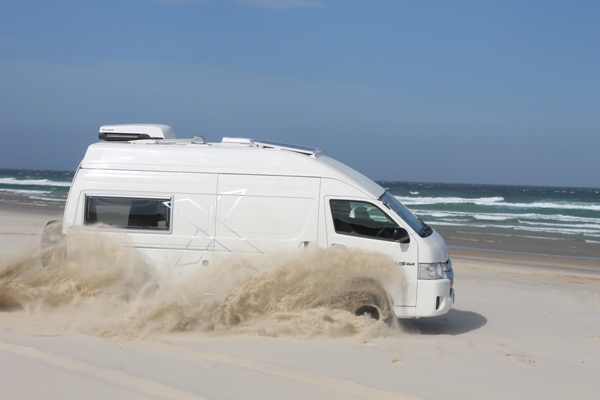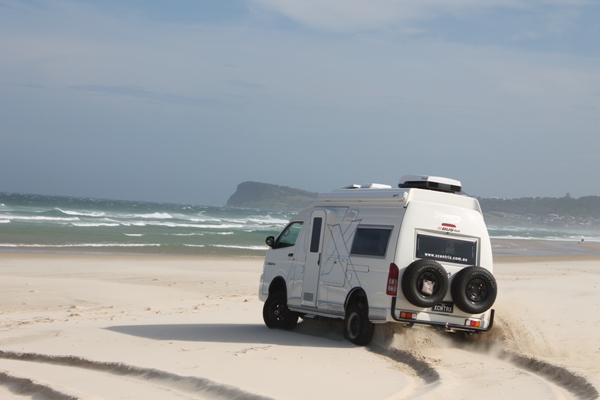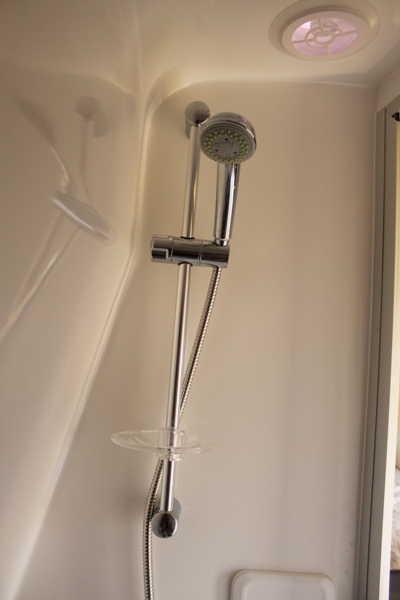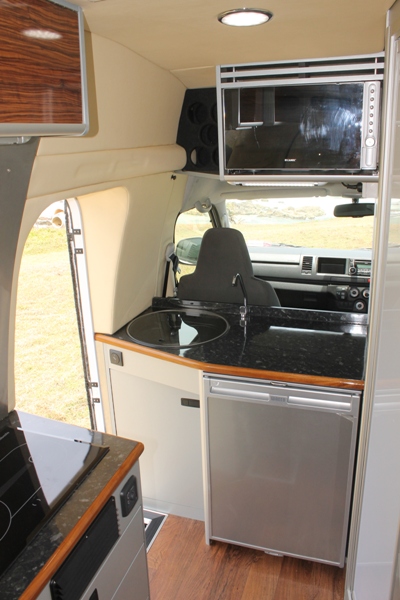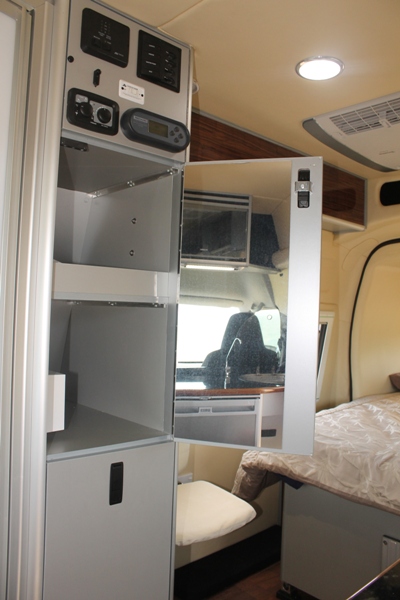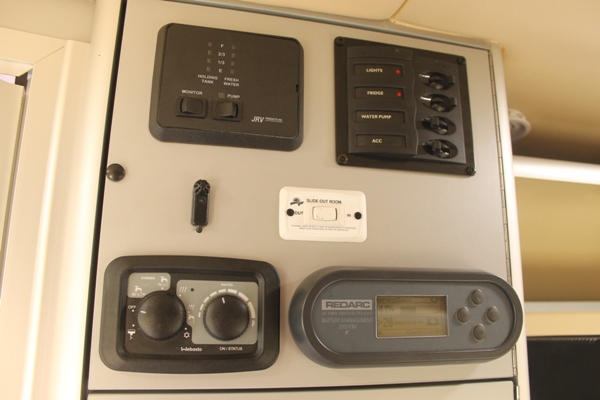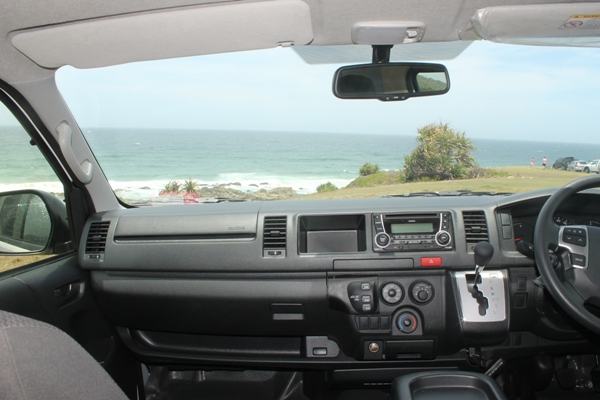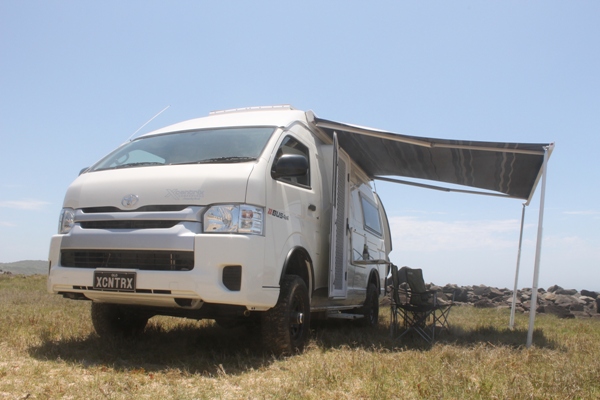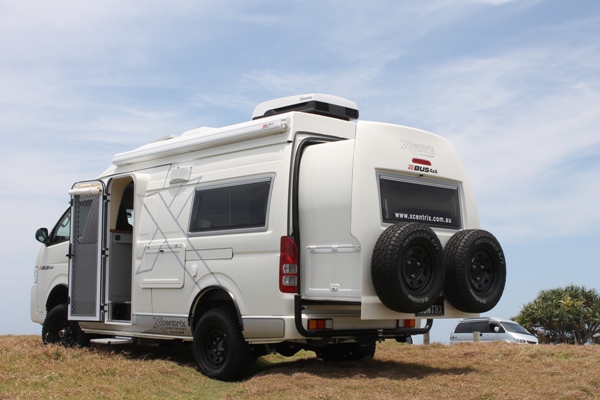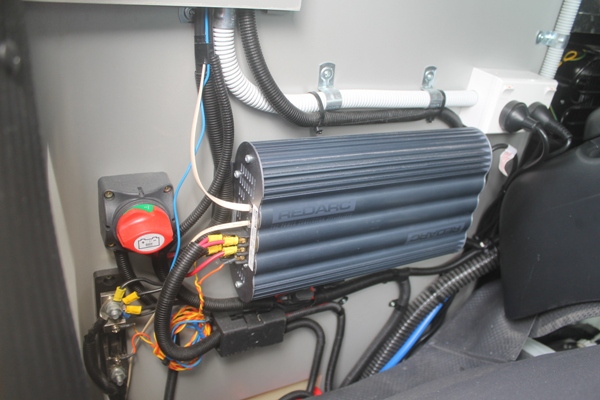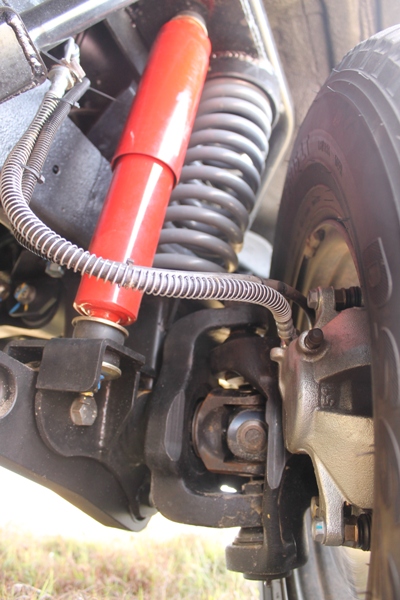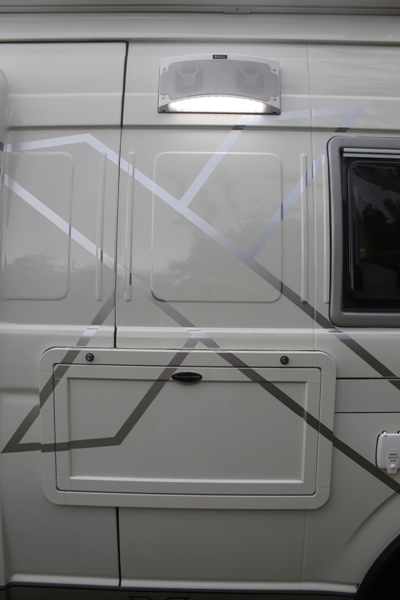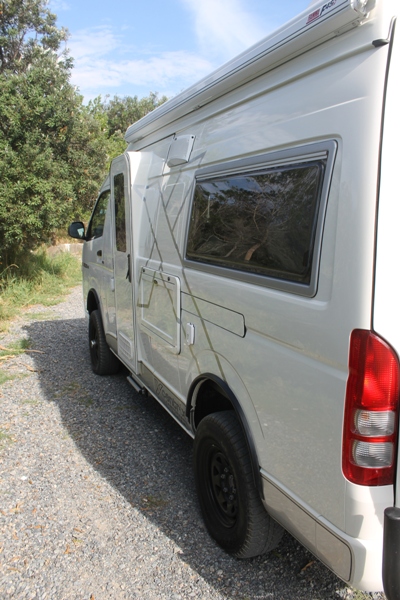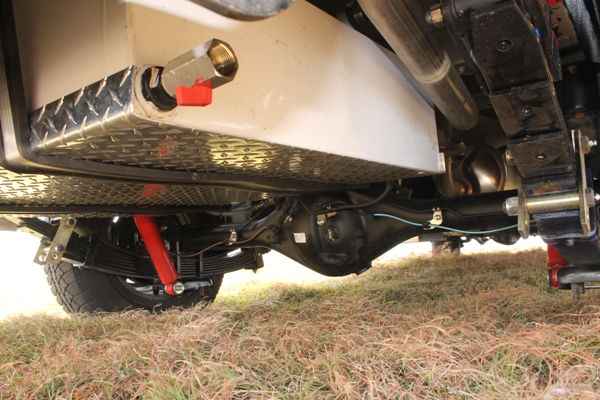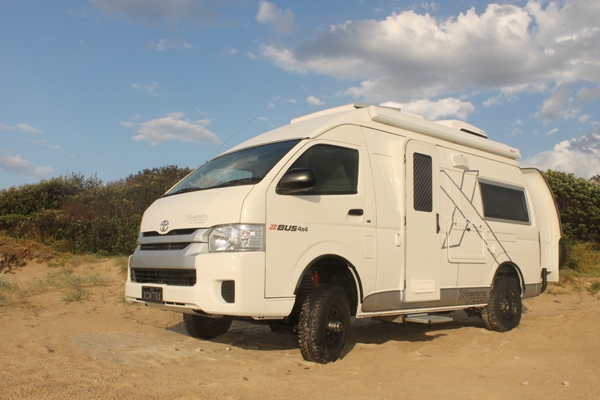As funny as it was to watch I couldn’t stand by any longer. I ran over to help poor Jamie land the wayward nylon kite he was flying to fashion a flysheet for his tent, after all that’s what it actually was. Though still warm, the night was one of wind-blown, sand-lashed storm. Despite being weighed down inside by cushions Jamie’s tent still bore airborne intentions but the sand piling up nicely against the interior walls added ballast. Jamie was a brave man.
Unlike me. Molly-coddled and cosseted journo up from the big smoke to sample the credibility of the Autarky motorhome from Xcentrix Campervans, the south-east Queensland specialist manufacturer where Jamie Fletcher works with owner Nick Reed. Surfers both, they were used to wild night like this near the dunes. Rather than courage, Jamie had possibly drawn the short straw. Nick had his Mitsubishi Delica Xcentrix campervan, I had the Autarky, and Jamie had silica towers.
Some acclimatisation time is always good when jumping into a new vehicle. First task for me aboard the Autarky – from the Greek, roughly meaning self-sufficiency – was to back out of a tight car park space. Even with a reversing camera in the rear-view mirror I still appreciated a guide from the Xcentrix boys. Nerves, and all that, – I didn’t want to scrape the only version of this stunning white conversion before we’d even kicked off.
We should explain that the Autarky 4X4 is born of collaboration between Xcentrix Custom Campervans and Bus 4X4 that has been to develop a full off-road campervan that sits below the larger offerings in terms of size, but not in terms of manoeuvrability and capability. All while maintaining a level of comfort and convenience that’s not readily available to Australian consumers in a compact vehicle package, and certainly not one with a low-range gearbox and an onboard shower/toilet combo.
The Bus 4X4 conversion element was immediately evident out on the road to our first location at Cabarita to buy supplies. Replacing the independent torsion bar set-up, a live axle now lives under the HiAce front end. There was a familiar feel reminiscent of 4WD trips, with a less than precise steering feedback not helped by having to dial in your efforts to combat the sudden gusts of wind that had made the landing at the Gold Coast airport such a thrill. It wasn’t wayward and before long was simply part of the mental programming required with any unfamiliar vehicle.
Specialists in mine-spec vehicles and larger off-road conversions including motorhomes on Coasters and Ivecos, Bus 4X4 has grafted a US New Process transfer case and a Dana 44 front axle/diff (think Jeep tough) under the HiAce. A six-leaf spring pack rear and coil front are controlled with Pedders shock absorbers. The suspension lift has added 145mm with actual ground clearance now at 185mm. Warn freewheeling hubs have been installed on the front to aid with fuel economy by running in two-wheel drive and to reduce steering component wear. It’s only a case of stopping to lock in the hubs when four-wheel drive is required. Once locked in, two to four high can be activated on the move while a full stop is necessitated for high to low-range selection. A US brand limited slip diffs occupy front and rear diff pumpkins, but Toyota-spec can be installed. Bus 4X4 now offers a similar conversion that uses full-time four-wheel drive from the Prado.
For the same reason I was worried in the car park – the aim of the test is to do as much as we can with the Autarky off-road without risking damage; this one’s for sale.
We were allowed to use all the onboard facilities except the loo. So after a run round the supermarket we loaded the Waeco 110L fridge with the consumables. Items that didn’t require chilling were placed in the neat three-stack roller drawer that is part of the tall storage next to the offside bathroom. Three more drawers live under the cooktop opposite the bathroom, and to the right of the entry door.
The entry door has been a labour for Nick and Jamie. Replacing the standard sliding door of most campervans (that would be impractical with the interior layout) they have moulded a custom ingress complete with Roamsafe security door and insect screen and roll down interior blind. It’s a rattle-free installation and has a Thule electric fold-out step (as an option). Either side of the lower onboard step is an access port to the factory Toyota jack, etc. (right) and the 12L diesel tank (left) for the Webasto diesel system that fuels the cooker, heating and hot water on this model. Gas can be optioned and the bottle would live under the sink (with hot/cold mixer, and smoked glass flip lid) on the work surface above the fridge to the left inside the door. The laminated solid teak bench area has open access to the cab, and the view beyond. There is also a chilled drinking water tap next to the sink. Above, the bench, at head height is provision for an optional microwave and there’s an inbuilt wine rack, too. Nice touch.
Given Nick’s professional credentials as a cabinet maker with years of experience with names like Swagman and Paradise, as well as a self-employed custom entrepreneur, the appearance and execution of the cabinetry is first rate.
If anyone laments the lack of a whizz-bang campervan door the driver’s side slider remains and provides access to the toilet cassette and tool stowage and hours of fun annoying your neighbours in the middle of the night. If you’re so inclined.
The toilet is a Dometic unit with a ceramic bowl which it shares a commodious (geddit) fully moulded bathroom with a flexible shower hose and vanity sink. The bathroom is also equipped with a LED lighting and a solar exhaust fan. A particularly attractive opaque acrylic door separates the bathroom from the cabin – secured for travel by a small elastic loop that hasn’t the propensity to loosen or break.
With similarity to the world in general, defined roles are quite important in campervan life. The Autarky’s fibreglass roof adds 200mm of headroom, but given the space restrictions, especially when cooking is involved, freedom of movement can be a luxury and intention of direction is best being well communicated. There is room to pass while culinary feats are performed. With a quick sidestep from the sink (to the right) or from the ceramic cooktop (and left) however, there is the option to reinforce the gender stereotypes applicable to your particular living arrangements with seating available for the non-working, or perhaps peeling, operative.
Inside, this takes the form of two sturdy folding chairs attached to either side of the van between the kitchen and the bedroom. Sturdy also applies to the upholstery and there could be more cushion on the seat base – although these aren’t designed as recliners, they are short-term accommodation for use with the adjustable table that is secured under the base of the lift-up queen-size bed. Options for the Autarky include a lumbar support pack for the dining chairs.
A 19-in TV is secured to the wall above the offside dining chair and is ideal for viewing in bed; it’s a tad awkward from the seated position under it. The dining table and kitchen bench provide reasonable preparation space, but perhaps some kind of flat insert could be worked out for the top of the pull-out drawers next to the bathroom. That way the kitchen and table could be used separately if indoor living was enforced due to prolonged unseasonal conditions. (‘You should have been here last week, mate!’)
Outside, the Fiamma three-metre awning offers plenty of shaded living space in which to set out your outdoor furniture. There’s a fold-out table from the near side of the van and a Bluetooth RVMedia audio speaker and light above for entertainment and illumination. There is also an external shower on the opposite side of the vehicle, next to the optional insulated and ventilated generator box built into the underside of the slide out. And van power is managed by a Redarc 15 amp BMS for 12/240V inputs with a 120W solar panel on the roof and two 105 amp house batteries inside. The monitor and switches for the Autarky’s electrics are positioned on the bulkhead by the bathroom. A lithium battery can be optioned.
So we’ve saved the party piece until last. Besides the full off-road conversion the HiAce is now equipped with a unique rear slide out that extends the bedroom and living area by 800mm. It’s also a well-engineered and strong unit, taking the strain of two spare wheels shod with 16-in all-terrain pattern Light Truck tyres. Once open, there are ports on either side that grant external access the very large under-bed storage area. Push button activation draws slide-out matters to a close.
With the exception of the TDV8 engine employed in single and twin-turbo variants in the GXL wagon/79 Series utes and 200 Series LandCruisers respectively, Toyota isn’t known for packing powerful diesels into its commercial range. Look at the HiLux compared to competition from Ford/Mazda and Volkswagen. So the HiAce struggles to summon the numbers against the likes of Fiat, Mercedes-Benz and Volkswagen (again) in the campervan market. Drivetrains are decidedly low-tech too, but on the flipside you won’t (often) be left stranded in the bush for want of spares with a Toyota. Which, given the bush-bound aspirations of the Autarky is a good thing.
On the subject of numbers, with the modification and resultant certification work on this particular Tojo, the GVM has lifted to 3880kg with a payload of around 220kg after fuel and water has been added, according to Xcentrix. Given the increased roof height and profile then, even with the rake of the roof’s leading edge, leisurely performance is all you can expect. We spent time on the open highway during our two days with the vehicle and never felt to be vulnerable due to lack of power. My only concern from this part of the experience was in cabin noise from a combination of wind, road and engine. Standard fuel capacity is currently 75 litres with a 130-litre tank on the cards – again better in keeping with the touring theme.
Obviously the major shift away from commercial application is in the camper. The trimming is attractive in choice of finish with marine vinyl backed with foam Insulbreak and Earthwool insulation and fire-retardant materials. There are plenty of cupboards and LED downlights or reading lights are in thoughtful positions. On both sides of the bed are USB ports atop small shelves for phones, remotes, etc. and the three large windows (themselves with insect screens and blinds) offer plenty of light and ventilation and there’s an optional Truma Aventa air-conditioner.
In practical terms, three of us ate in the vehicle during the storm – the wind never went away – and were in an out making coffee, etc. and it wasn’t a melee. The interior is finished with waterproof materials and given the amount of sand in the air it was easily swept or brushed clean. I slept in the vehicle overnight and don’t even recall falling asleep – I was out like the proverbial which is not always easy in a strange bed. I left the offside rear window slightly open for pleasant ventilation and despite the weather – when it poured down toward the morning – I wasn’t disturbed by the prevailing conditions. So that’s a tick in the comfort stakes. Being able to move the bed back by almost a metre is, for want of a better cliché, adding a new dimension to a campervan.
The first evening we’d concentrated on photography rather than driving but given the grating weather, with sand in everything, the strong wind and my borrowed lightweight tripod had made a mockery of my attempts at long exposures.
We had dropped the tyre pressures in anticipation of the sand driving. Initially to low 20s psi but even that failed to produce a noticeable bag in the sidewalls of the Light Truck tyres so we went to high teens to achieve the result that would hopefully give us the elongated footprint we were after in the sand. To be honest, given the firm nature of Seven Mile Beach outside Lake Ainsworth we would have been fine on the higher pressures but anything’s better than getting bogged. Which never looked likely. Even in the soft, channelled beach entry the Autarky motored through in four-high, drive, without a murmur of complaint. It’s in surfaces like these that the ride takes on different characteristics. The beach, especially in windy conditions, can throw up soft patches and ridges you can’t see until the last minute. While we weren’t going fast, good suspension helps soften the downward crash of a surprised and heavy rear end.
The steering, too, comes into its own. The less precise inputs are perfect on sand where you are thinking ahead of your movement and swinging in arcs rather than pulling quick reactionary turns that can sap momentum and bring out the sand ladders. In the late afternoon light, with sand streaming ahead of us in airborne ribbons across the tops of new mini dunes we chugged happily along the beach; given the decent approach and departure angles (see specs panel) and clearance under a relatively short belly I reckon the Autarky would have no problem with dunes of a more imposing nature. Swap the LSDs for locking diffs and it would be nearly unstoppable.
After a cleansing swim in the tannin waters of Lake Ainsworth (remarkably warm and restorative) and reinflating the tyres back to road pressures we headed to South Ballina and the longest stretch of beach this townie has seen in a long time. There was a longer stretch of access track to the waterfront and it was deep, soft sand. We lowered the pressures to low 20s this time and dropped the transfer into low-range. A doddle. By this time I was convinced of the Autarky’s sand prowess so we took plenty of photos to finish the exercise. Nick and Jamie, who’d been dying for surf the whole time, were confounded after only 10 minutes in the ocean before a shark forced them out of the water. A signal that it was time to take the visitor back to the airport.
And a drive back to the Gold Coast that allowed me time to ponder the Xcentrix Autarky. It’s the culmination of Nick’s personal likes and professional experience – as often any personal statement like this can be. It’s going to take you to the best surfing spots, round the corner or if you choose to drive to Bells from the east coast via Finke. It’s comfortable, it’s technically innovative – maybe over specified – in that it’s taken a major mechanical ($40K+) conversion for its off-road ability and that single element has taken the budget with it. It’s a $199,000 proposition.
But currently, there’s nothing quite like it in such a compact package. Some vehicles come close but none have it all. So if you want it all, and don’t want a large expedition rig, or a delicate half-measures off-road package and you don’t want to rough it, you want the Autarky; maybe you’re an Xcentric too.
Click here for further details about Xcentrix Campervans.
Words and photos by Tim Scott.


